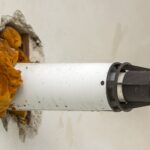Picture this: a minor issue overlooked on your roof could lead to a cascade of complications within your home. Your plumbing stack boot, a critical yet often neglected component, plays an essential role in ensuring your roof remains leak-free. Understanding and addressing its condition could save you from costly repairs and damage.
- Discover the critical role plumbing stack boots play in preventing roof leaks and safeguarding your home.
- Identify the common signs of wear that suggest it might be time for a replacement of your plumbing stack boot.
- Follow a step-by-step guide that makes replacing your plumbing stack boot straightforward and effective.
Adopting a proactive approach to maintaining your plumbing stack boot will ensure peace of mind, knowing your home is protected from water damage. This article will guide you through the process, giving you the knowledge you need to act with confidence.
Understanding the Role of Plumbing Stack Boot Replacement in Roof Leak Prevention
Plumbing stack boots play a crucial role in maintaining a leak-free roof, acting as a protective barrier against water intrusion. These components, found at the base of plumbing vent stacks, ensure a secure seal where pipes penetrate your roof.
Over time, the material of these boots can degrade due to exposure to harsh weather conditions, UV rays, and moisture. When this seal is compromised, it can allow rainwater to seep through and cause significant water damage. This can lead to costly repairs not only to the roof but also to the interior of your home.
Regular inspection and timely plumbing stack boot replacement are integral to roof leak prevention. By replacing these components as needed, you safeguard your home against leaks, preserving the structural integrity of your roof and maintaining its efficiency. Ignoring these maintenance tasks can result in extensive damage and increase maintenance costs over time.
Understanding the function and maintenance needs of plumbing stack boots is essential for homeowners aiming to keep their roofs intact and dry. Proactively addressing wear and tear can prevent significant inconvenience and expense down the line.
Identifying Signs of Wear in Your Plumbing Stack Boot
Recognizing the signs of wear in your plumbing stack boot is vital for preventing roof leaks and maintaining the durability of your roofing system. Common indicators that your plumbing stack boot requires replacement include visible cracks, brittleness, or color fading in the boot material. These signs often point to prolonged exposure to elements, which can weaken the boot’s protective capabilities.
Another indicator is water stains on your ceiling or walls, suggesting that water is entering your home through a compromised seal. On the roof itself, you might notice that the boot no longer fits snugly around the pipe, or there is visible separation between the boot and the roofing material.
Regular inspections, especially after severe weather events, can help you detect these issues early. If you observe any of these symptoms, it’s crucial to take prompt action. Replacing the worn plumbing stack boot can avert potential water damage, safeguarding both the interior and exterior of your home from expensive repairs.
Step-by-Step Guide to Plumbing Stack Boot Replacement: Ensuring a Leak-Free Roof
A plumbing stack boot plays a vital role in preventing roof leaks by sealing the area where plumbing pipes protrude from your roof. Damaged or worn-out stack boots can lead to significant water damage, so understanding how to replace them is essential. This comprehensive guide will take you through each step to safely and effectively replace your plumbing stack boot, ensuring a leak-free roof.
Prepare for the Replacement: Before starting, ensure you have all necessary tools and materials, including a new plumbing stack boot, a utility knife, a pry bar, roofing nails, roofing cement, and a hammer. Safety is paramount, so don’t forget a sturdy ladder and protective gear.
Assess the Current Situation: Begin by assessing the condition of your existing stack boot. Carefully climb onto the roof and locate the plumbing vent pipe. Look for any visible signs of damage, like cracks or deterioration, around the boot’s base.
Remove the Damaged Stack Boot: Once assessed, gently use a utility knife to cut away any sealants or roofing materials around the base of the old stack boot. Take care not to damage the surrounding shingles. After cutting, employ a pry bar to lift the damaged boot off the vent pipe.
Install the New Stack Boot: Fit the new plumbing stack boot over the vent pipe. Ensure that it sits snugly against the roof’s surface, covering the pipe effectively. It’s crucial to align the boot’s base with the roof pitch to ensure a secure fit.
Secure the New Boot: With the new stack boot in place, use roofing nails to anchor the boot’s flange into the roof. Space the nails appropriately to provide adequate support without causing additional damage to the roofing material.
Seal the Installation: Apply a generous layer of roofing cement around the edges of the new stack boot. This helps create a waterproof seal, preventing potential leaks. Pay special attention to any areas where the boot meets the shingles.
Inspect for Stability: After installation, take a moment to inspect your work. Ensure the boot is firmly in place and the seal around it is airtight. A stable installation now can save you from costly repairs in the future.
By following these steps, you can effectively replace your plumbing stack boot and maintain a leak-free roof. Regular inspections and timely replacements are key to protecting your home from possible water damage.
Frequently Asked Questions about Plumbing Stack Boot Replacement
What is a plumbing stack boot?
A plumbing stack boot is a flexible flashing that seals the gap between plumbing stack pipes and the roof to prevent water leaks.
Why is replacing a worn plumbing stack boot important?
Replacing a worn boot is crucial because it prevents water leaks and potential water damage to your roof and interior spaces.
How can I identify a damaged plumbing stack boot?
- Cracks in the rubber boot
- Water stains inside your home
- Visible gaps around the stack pipe
are common signs of damage.
Can I replace a plumbing stack boot myself?
Yes, you can replace it yourself by following a detailed step-by-step guide, ensuring roof safety while doing so.
What tools are needed for a stack boot replacement?
You’ll need a utility knife, caulk gun, screwdriver, ladder, and a replacement boot for the task.
How often should a plumbing stack boot be replaced?
It’s advisable to inspect and potentially replace it every 10-15 years or sooner if signs of wear appear.





